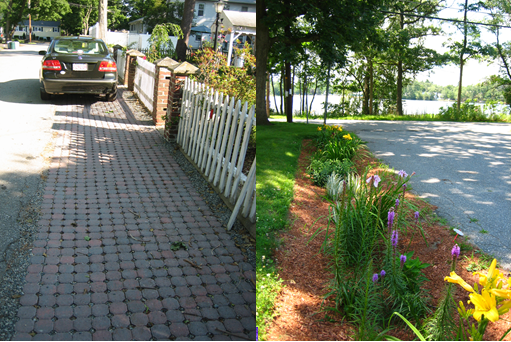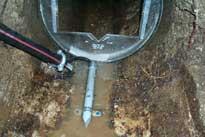Project Description
Location: Wilmington, MA, near Silver Lake
Purpose:
- Demonstrate the use of a variety of low-impact development (LID) retrofit techniques to reduce nonpoint source pollution to a recreational lake.
- Quantify the reduction in runoff and the improvement in water quality resulting from the collective LID strategies.
- Reduce or eliminate contamination of the lake by neighborhood stormwater by reducing runoff volume and improving runoff quality.
- Increase groundwater recharge in neighborhood abutting the lake.
Details: Silver Lake is an important recreation area that supports swimming, fishing, wildlife viewing, and boating. However, the lake’s quality was deteriorating from nutrients, sediment, and bacteria entering the lake from the surrounding stormwater system (which includes several pipe outlets to the lake) and nonpoint source runoff. Beach closures due to high bacteria counts had occurred repeatedly for many years prior to this demonstration.
This project incorporated several LID techniques to replace the conventional stormwater collection system in two streets draining to Silver Lake. Stormwater flow paths were disconnected from the piped drainage system by directing stormwater to rain gardensand porous pavers. Twelve rain gardens were located in the roadway rights-of-way. The rain gardens provide treatment as water percolates through the soil, and nutrients and contaminants are processed by the plants. The roadway edges in two areas along Silver Lake Avenue were resurfaced with porous pavers with underlying infiltration beds. The porous pavers allow stormwater to soak into the ground between the paving units.
In addition to the LID techniques, the work included replacement of two catch basins with deep-sump catch basins, to improve capture and removal of sediment, and excavation of accumulated sediment in the area around an outfall to Silver Lake, in order to restore proper flow through the drainage system.
Project partner: Town of Wilmington
Design/Engineering/Construction oversight: Geosyntec Consultants
Construction and three years of maintenance: Cali Corporation
Monitoring and Analysis: U.S. Geological Survey
Ongoing Maintenance: Wilmington Department of Public Works and neighborhood residents
Site Photos and Aerial Schematic
Milestones
- Construction completed May 2006
- Monitoring of stormwater quality and quantity conducted by USGS:
- Preconstruction: August - November 2005
- Postconstruction: June 2006 - December 2007
- “Garden Party” (raingarden maintenance work day) with neighborhood residents held June 2008: residents selected additional plantings for the raingardens, learned about long-term maintenance needs, and enjoyed a day of gardening.
Costs
Design/engineering/construction management (combined costs for Demonstration # 3 and # 4): $92,000
Construction, and three years of maintenance (combined costs for Demonstration # 3 and # 4): $355,000
Data Collection and Analysis
The U.S. Geological Survey collected water samples from a storm drain pipe on Silver Lake Avenue. Two types of equipment were used. An automated sampler collected water quality samples, which were analyzed for a range of parameters, including bacteria. A continuous flow monitor provided data on the quantity of stormwater discharged at the sampling point. Preconstruction conditions were compared to post-construction conditions to detect any changes in water quality associated with the LID practices and to determine whether and by how much the LID practices reduce the quantity of surface runoff from the surrounding neighborhood.
This project was closely coordinated with additional LID work occurring across the lake at the town beach. For details, see Demonstration 3: Permeable Paving Materials and Bioretention in a Parking Lot.
Key Results and Conclusions
- For small storms, less than or equal to 0.26 inches, the LID features reduced runoff volume relative to pre-installation conditions (although sample sizes were too small for the reductions to be statistically significant).
- The LID features fully retained the runoff generated by many storms in this small size category, whereas all storms in this size category produced measurable runoff during the pre-installation monitoring.
- For larger storms, greater than 0.26 inches, pre- and post-LID conditions performed similarly.
- Storms less than or equal to 0.26 inches represent the majority of annual rainfall events, and comprised 60% of the storms monitored during the study.
- Water quality sampling was limited to the larger storms, to ensure sufficient volume for water quality analysis, and no differences in pollutant concentrations or loads were discerned.
- Monitoring suggested that the LID features in the Silver Lake neighborhood study area reduced the effective impervious area from 10% to 4.5%.
Publications
- USGS Scientific Investigation Report 2010-5007
- USGS circular
- Silver Lake Interpretive Sign
- Ipswich River Targeted Watershed Grant Fact Sheet: Three Low-Impact Development Case Studies
- Town's Maintenance Protocol
- Homeowner's Guide to Raingarden Maintenance
- Project brochure sent to all town residents
- Roy, Steven P. and Andrea Braga. February 2009. Saving Silver Lake. Civil Engineering—ASCE, Vol. 79, No. 2, pp. 72-79.

